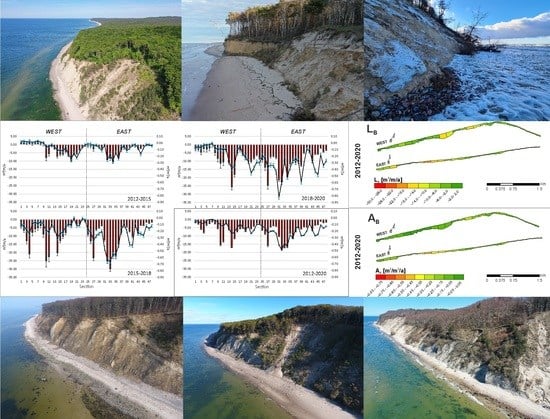Assessment of Moraine Cliff Spatio-Temporal Erosion on Wolin Island Using ALS Data Analysis
Abstract
1. Introduction
2. Materials and Methods
2.1. Research Area
2.2. Data Sources
2.3. GIS Analysis
3. Results
3.1. Hydrodynamic Conditions of Coastal Erosion
3.2. Volume Changes of the Cliff Coast
4. Discussion
4.1. Factors Controling the Erosion of the Cliffs of the Wolin Island
4.2. The Dynamics of the Cliff Coast of the Wolin Island in Comparison to the Shores of the World
5. Conclusions
Supplementary Materials
Author Contributions
Funding
Data Availability Statement
Acknowledgments
Conflicts of Interest
References
- Kostrzewski, A.; Zwoliński, Z.; Winowski, M.; Tylkowski, J.; Samołyk, M. Cliff top recession rate and cliff hazards for the sea coast of Wolin Island (Southern Baltic). Baltica 2015, 28, 109–120. [Google Scholar] [CrossRef]
- Church, J.A.; Clark, P.U.; Cazenave, A.; Gregory, J.M.; Jevrejeva, S.; Levermann, A.; Merrifield, M.A.; Milne, G.A.; Nerem, R.S.; Nunn, P.D.; et al. Sea Level Change, Climate Change 2013 the Physical Science Basis. Contribution of Working Group I to the Fifth Assessment Report of the Intergovernmental Panel on Climate Change; Stocker, T.D., Qin, G.-K., Plattner, M., Tignor, S.K., Allen, J., Boschung, A., Nauels, Y., Xia, V.B., Midgley, P.M., Eds.; Cambridge University Press: Cambridge, UK; New York, NY, USA, 2013; pp. 1137–1216. [Google Scholar]
- Zwoliński, Z. Globalne zmiany klimatu i ich implikacje dla rzeźby Polski. Landf. Anal. 2011, 15, 5–15. [Google Scholar]
- Frydel, J.; Mil, L.; Szafarin, T.; Koszka-Maroń, D.; Przyłucka, M. Zmienność czasowa i zróżnicowanie przestrzenne wielkości i tempa erozji klifu Zatoki Usteckiej w rejonie Orzechowa. Landf. Analy. 2017, 34, 3–14. [Google Scholar] [CrossRef]
- Terefenko, P.; Giza, A.; Paprotny, D.; Kubicki, A.; Winowski, M. Cliff retreat induced by series of storms at Międzyzdroje (Poland). J. Coast. Res. 2018, SI 85, 181–185. [Google Scholar] [CrossRef]
- IPCC, Intergovernmental Panel on Climate Change. Global Warming of 1.5 °C an IPCC Special Report on the Impacts of Global Warming of 1.5 °C Above Preindustrial Levels and Related Global Greenhouse Gas Emission Pathways, in the Context of Strengthening the Global Response to the Threat of Climate Change. 2018. Available online: http://www.ipcc.ch/report/sr15/ (accessed on 28 October 2019).
- IPCC, Intergovernmental Panel on Climate Change. Climate Change and Land: An IPCC Special Report on Climate Change, Desertification, Land Degradation, Sustainable Land Management, Food Security, and Greenhouse Gas Fluxes in Terrestrial Ecosystems. 2019. Available online: https://www.ipcc.ch/report/srccl/ (accessed on 28 October 2019).
- Winowski, M.; Kostrzewski, A.; Tylkowski, J.; Zwoliński, Z. The importance of extreme processes in the development of the Wolin Island cliffs coast (Pomeranian Bay-Southern Baltic). In Proceedings of the International Scientific Symposium New Trends in Geography, Ohrid, North Macedonia, 3–4 October 2019; pp. 99–108. [Google Scholar]
- Tylkowski, J.; Winowski, M.; Hojan, M.; Czyryca, P.; Samołyk, M. Influence of hydrometeorological hazards and sea coast morphodynamics on development of Cephalanthero rubrae-Fagetum (Wolin Island, the southern Baltic Sea). Nat. Hazards Earth Syst. Sci. 2021, 21, 363–374. [Google Scholar] [CrossRef]
- Sepp, M.; Post, P.; Jaagus, J. Long-term changes in the frequency of cyclones and their trajectories in Central and Northern Europe. Nord. Hydrol. 2005, 36, 297–309. [Google Scholar] [CrossRef]
- Sztobryn, M.; Stigge, H.-J.; Wielbińska, D.; Weidig, B.; Stanisławczyk, I.; Kańska, A.; Krzysztofik, K.; Kowalska, B.; Letkiewicz, B.; Mykita, M. Storm Surges in the Southern Baltic Sea (Western and Central Parts); BSH: Rostock, Germany; Hamburg, Germany, 2005; pp. 1–74. [Google Scholar]
- Wolski, T. Temporal and Spatial Characterization of Extreme Baltic Sea Levels; Scientific Publisher of the University of Szczecin: Szczecin, Poland, 2017; ISBN 978-83-7972-091-0. [Google Scholar]
- Rosentau, A.; Bennike, O.; Uścinowicz, S.; Miotk-Szpiganowicz, G. The Baltic Sea Basin. In Submerged Landscapes of the European Continental Shelf: Quaternary Paleoenvironments, 1st ed.; Flemming, N.C., Harff, J., Moura, D., Burgess, A., Bailey, G.N., Eds.; John Wiley & Sons Ltd.: Hoboken, NJ, USA, 2017; pp. 103–133. [Google Scholar] [CrossRef]
- Wenyu, L.; Peng, G. Continuous monitoring of coastline dynamics in western Florida with a 30-Year time series of Landsat imagery. Remote Sens. Environ. 2016, 179, 196–209. [Google Scholar]
- Nikolakopoulos, K.; Kyriou, A.; Koukouvelas, I.; Zygouri, V.; Apostolopoulos, D. Combination of aerial, satellite, and UAV photogrammetry for mapping the diachronic coastline evolution: The case of Lefkada Island. ISPRS Int. J. Geo-Inf. 2019, 8, 489. [Google Scholar] [CrossRef]
- Tylkowski, J. Hydro-meteorological conditions underpinning cliff-coast erosion on Wolin Island, Poland. Przegląd Geogr. 2018, 90, 111–135. [Google Scholar] [CrossRef]
- Tylkowski, J.; Hojan, M. Threshold values of extreme hydrometeorological events on the Polish Baltic coast. Water 2018, 10, 1337. [Google Scholar] [CrossRef]
- Terefenko, P.; Giza, A.; Paprotny, D.; Walczakiewicz, S. Characteristic of winter storm Xavier and its impacts on coastal morphology: Results of a case study on the polish coast. J. Coast. Res. 2020, SI 95, 684–688. [Google Scholar] [CrossRef]
- Kolander, R.; Morche, D.; Bimböse, M. Quantification of moraine cliff coast erosion on Wolin Island (Baltic Sea, northwest Poland). Baltica 2013, 26, 37–44. [Google Scholar] [CrossRef]
- Uścinowicz, G.; Kramarska, R.; Kaulbarsz, D.; Jurys, L.; Frydel, J.; Przezdziecki, P.; Jegliński, W. Baltic Sea coastal erosion; a case study from the Jastrzębia Góra region. Geologos 2014, 20, 259–268. [Google Scholar] [CrossRef]
- Swirad, Z.M.; Young, A.P. Automating coastal cliff erosion measurements from large-area LiDAR datasets in California, USA. Geomorphology 2021, 389, 107799. [Google Scholar] [CrossRef]
- Young, A.P.; Guza, R.T.; Matsumoto, H.; Merrifield, M.A.; O’Reilly, W.C.; Swirad, Z.M. Three years of weekly observations of coastal cliff erosion by waves and rainfall. Geomorphology 2021, 375, 107545. [Google Scholar] [CrossRef]
- Averes, T.; Hofstede, J.L.A.; Hinrichsen, A.; Reimers, H.C.; Winter, C. Cliff retreat contribution to the littoral sediment budget along the baltic sea coastline of Schleswig-Holstein, Germany. J. Mar. Sci. Eng. 2021, 9, 870. [Google Scholar] [CrossRef]
- Earlie, C.; Masselink, G.; Russell, P. The role of beach morphology on coastal cliff erosion under extreme waves. Earth Surf. Processes Landf. 2018, 43, 1213–1228. [Google Scholar] [CrossRef]
- Dudzińska-Nowak, J.; Wężyk, P. Volumetric changes of a soft cliff coast 2008–2012 based on DTM from airborne laser scanning (Wolin Island, southern Baltic Sea). J. Coast. Res. 2014, 70, 59–64. [Google Scholar] [CrossRef]
- Kaminsky, G.M.; Baron, H.M.; Hacking, A.; McCandless, D.; Parks, D.S. Mapping and Monitoring Bluff Erosion with Boat-Based LIDAR and the Development of a Sediment Budget and Erosion Model for the Elwha and Dungeness Littoral Cells, Clallam County, Washington; Washington State Department of Ecology Coastal Monitoring and Analysis Program, and Washington State Department of Natural Resources: Washington, DC, USA, 2014; pp. 1–44. [Google Scholar]
- Szruba, M. Sposoby ochrony brzegów morskich. Nowocz. Bud. Inżynieryjne 2017, 1, 60–63. [Google Scholar]
- Hanson, H.; Brampton, A.; Capobianco, M.; Dette, H.H.; Hamm, L.; Laustrup, C.; Lechuga, A.; Spanhoff, R. Beach nourishment projects, practices, and objectives—A European overview. Coast. Eng. 2002, 47, 81–111. [Google Scholar] [CrossRef]
- Ostrowski, R.; Pruszak, Z.; Babakow, A. Conditions of seashores and methods of their protection in Kaliningrad Oblast and Lithuania. Inżynieria Morska I Geotech. 2013, 3, 191–197. [Google Scholar]
- Hojan, M.; Rurek, M.; Krupa, A. The Impact of Sea Shore Protection on Aeolian Processes Using the Example of the Beach in Rowy, N Poland. Geosciences 2019, 9, 179. [Google Scholar] [CrossRef]
- Van der Wal, D. Aeolian Transport of Nourishment Sand in Beach-Dune Environments; University of Amsterdam: Amsterdam, The Netherlands, 1999; pp. 1–157. ISBN 90-6787-053-6. [Google Scholar]
- Van der Wal, D. Effects of fetch and surface texture on aeolian sand transport on two nourished beaches. J. Arid Environ. 1998, 39, 533–547. [Google Scholar] [CrossRef]
- Davidson-Arnott, R.G.D.; Law, M.N. Seasonal patterns and controls on sediment supply to coastal foredunes, Long Point, Lake Erie. In Coastal Dunes; Form and Process; Nordstrom, K.F., Psuty, N.P., Carter, R.W.G., Eds.; Wiley: Chichester, UK, 1990; pp. 177–200. ISBN 978-0-471-91842-4. [Google Scholar]
- Masria, A.; Negm, A.; Iskander, M.M.; Saavedra, O.C. Coastal protection measures, case study (Mediterranean zone, Egypt). J. Coast. Conserv. 2015, 19, 281–294. [Google Scholar] [CrossRef]
- Charlier, R.H.; Chaineux, M.C.P.; Morcos, S. Panorama of the history of coastal protection. J. Coast. Res. 2005, 21, 79–111. [Google Scholar] [CrossRef]
- Sallenger, A.H.; Krabill, W.; Brock, J.; Swift, R.; Manizade, S.; Stockdon, H. Sea-cliff erosion as a function of beach changes and extreme wave runup during the 1997–1998 El Niño. Mar. Geol. 2002, 187, 279–297. [Google Scholar] [CrossRef]
- Castedo, R.; Fernández, M.; Trenhaile, A.S.; Paredes, C. Modeling cyclic recession of cohesive clay coasts: Effects of wave erosion and bluff stability. Mar. Geol. 2013, 335, 162–176. [Google Scholar] [CrossRef]
- Castedo, R.; Murphy, W.; Lawrence, J.; Paredes, C. A new process-response coastal recession model of soft rock cliffs. Geomorphology 2012, 177–178, 128–143. [Google Scholar] [CrossRef]
- Castelle, B.; Marieu, V.; Bujan, S.; Splinter, K.D.; Robinet, A.; Sénéchal, N.; Ferreira, S. Impact of the winter 2013–2014 series of severe Western Europe storms on a double-barred sandy coast: Beach and dune erosion and megacusp embayments. Geomorphology 2015, 238, 135–148. [Google Scholar] [CrossRef]
- Sunamura, T. Rocky coast processes: With special reference to the recession of soft rock cliffs. Proc. Jpn. Acad. 2015, 91, 481–500. [Google Scholar] [CrossRef]
- Masselink, G.; Scott, T.; Poate, T.; Russell, P.; Davidson, M.; Conley, D. The extreme 2013/2014 winter storms: Hydrodynamic forcing and coastal response along the southwest coast of England. Earth Surf. Processes Landf. 2016, 41, 378–391. [Google Scholar] [CrossRef]
- Prémaillon, M.; Regard, V.; Dewez, T.J.B.; Auda, Y. GlobR2C2 (Global Recession Rates of Coastal Cliffs): A global relational database to investigate coastal rocky cliff erosion rate variations. Earth Surf. Dyn. 2018, 6, 651–668. [Google Scholar] [CrossRef]
- Łęczyński, L. Morpholitodynamics of the shoreface on the cliff coast at Jastrzębia Góra. Peribalticum 1999, 7, 9–20. [Google Scholar]
- Florek, W.; Kaczmarzyk, J.; Majewski, M. Dynamics of the Polish coast of Ustka. Geogr. Pol. 2010, 83, 51–60. [Google Scholar] [CrossRef]
- Brooks, S.M.; Spencer, T.; Boreham, S. Deriving mechanisms and thresholds for cliff retreat in soft-rock cliffs under changing climates: Rapidly retreating cliffs of the Suffolk coast, UK. Geomorphology 2012, 153–154, 48–60. [Google Scholar] [CrossRef]
- Young, A.P. Decadal-scale coastal cliff retreat in southern and central California. Geomorphology 2018, 300, 164–175. [Google Scholar] [CrossRef]
- De Sanjosé Blasco, J.J.; Gómez-Lende, M.; Sánchez-Fernández, M.; Serrano-Cañadas, E. Monitoring retreat of coastal sandy systems using geomatics techniques: Somo Beach (Cantabrian Coast, Spain, 1875–2017). Remote Sens. 2018, 10, 1500. [Google Scholar] [CrossRef]
- Young, A.P.; Flick, R.E.; O’Reilly, W.C.; Chadwick, D.B.; Crampton, W.C.; Helly, J.J. Estimating cliff retreat in southern California considering sea level rise using a sand balance approach. Mar. Geol. 2014, 348, 15–26. [Google Scholar] [CrossRef]
- Joyal, G.; Lajeunesse, P.; Morissette, A.; Bernatchez, P. Influence of lithostratigraphy on the retreat of an unconsolidated sedimentary coastal cliff (St. Lawrence estuary, eastern Canada). Earth Surf. Proc. Landf. 2016, 41, 1055–1072. [Google Scholar] [CrossRef]
- Epifânio, B.; Zêzere, J.L.; Neves, M. Identification of hazardous zones combining cliff retreat rates with landslide susceptibility assessment. J. Coast. Res. 2013, 165, 1681–1686. [Google Scholar] [CrossRef][Green Version]
- Uścinowicz, G.; Szarafin, T.; Pączek, U.; Lidzbarski, M.; Tarnawska, E. Geohazard assessment of the coastal zone—The case of the southern Baltic Sea. Geol. Q. 2021, 65, 1–12. [Google Scholar] [CrossRef]
- Westoby, M.J.; Brasington, J.; Glasser, N.F.; Hambrey, M.J.; Reynolds, J.M. Structure-from-Motion photogrammetry: A low-cost, effective tool for geoscience applications. Geomorphology 2012, 179, 300–314. [Google Scholar] [CrossRef]
- Mancini, F.; Dubbini, M.; Gattelli, M.; Stecchi, F.; Fabbri, S.; Gabbianelli, G. Using unmanned aerial vehicles (UAV) for high-resolution reconstruction of topography: The structure from motion approach on coastal environments. Remote Sens. 2013, 5, 6880–6898. [Google Scholar] [CrossRef]
- Gonçalves, G.R.; Pérez, J.A.; Duarte, J. Accuracy and effectiveness of low cost UASs and open source photogrammetric software for foredunes mapping. Int. J. Remote Sens. 2018, 39, 5059–5077. [Google Scholar] [CrossRef]
- Scarelli, F.M.; Sistilli, F.; Fabbri, S.; Cantelli, L.; Barboza, E.G.; Gabbianelli, G. Seasonal dune and beach monitoring using photogrammetry from UAV surveys to apply in the ICZM on the Ravenna coast (Emilia-Romagna, Italy). Remote Sens. Appl. Soc. Environ. 2017, 7, 27–39. [Google Scholar] [CrossRef]
- Young, A.P.; Ashford, S.A. Application of airborne LIDAR for seacliff volumetric change and beach-sediment budget contributions. J. Coast. Res. 2006, 22, 307–318. [Google Scholar] [CrossRef]
- Baroň, I.; Bečkovský, D.; Míča, L. Application of infrared thermography for mapping open fractures in deep-seated rockslides and unstable cliffs. Landslides 2014, 11, 15–27. [Google Scholar] [CrossRef]
- Grubbs, M. Beach Morphodynamic Change Detection using LiDAR during El Niño Periods in Southern CaliforniaA. Master’s Thesis, Faculty of the USC Graduate School University of Southern California, Los Angeles, CA, USA, 2017; pp. 1–156. [Google Scholar]
- Terefenko, P.; Wziatek, D.Z.; Dalyot, S.; Boski, T.; Lima-Filho, F.P. A high-precision LiDAR-based method for surveying and classifying coastal notches. ISPRS Int. J. Geo-Inf. 2018, 7, 295. [Google Scholar] [CrossRef]
- Quan, S.; Kvitek, R.G.; Smith, D.P.; Griggs, G.B. Using vessel-based LIDAR to quantify coastal erosion during El Niño and inter-El Niño periods in monterey Bay, California. J. Coast. Res. 2013, 29, 555–565. [Google Scholar] [CrossRef]
- Assenbaum, M. Monitoring Coastal Erosion with UAV lidar. GIM Int. 2018, 32, 18–21. Available online: https://www.gim-international.com/content/article/monitoring-coastal-erosion-with-uav-lidar (accessed on 23 November 2021).
- Uścinowicz, G.; Szarafin, T.; Jurys, L. Tracking cliff activity based on multi temporal digital terrain models—an example from the southern Baltic Sea coast. Baltica 2019, 32, 10–21. [Google Scholar] [CrossRef]
- Laporte-Fauret, Q.; Marieu, V.; Castelle, B.; Michalet, R.; Bujan, S.; Rosebery, D. Low-Cost UAV for high-resolution and large-scale coastal dune change monitoring using photogrammetry. J. Mar. Sci. Eng. 2019, 7, 63. [Google Scholar] [CrossRef]
- Pereira, E.; Bencatel, R.; Correia, J.; Félix, L.; Gonçalves, G.; Morgado, J.; Sousa, J. Unmanned air vehicles for coastal and environmental research. J. Coast. Res. 2009, SI 56, 1557–1561. [Google Scholar]
- ASPRS Las Specification. 2008. Available online: https://www.asprs.org/a/society/committees/standards/asprs_las_format_v12.pdf (accessed on 16 February 2022).
- Wiśniewski, B.; Wolski, T.; Giza, A. Adjustment of the European vertical reference system for the representation of the Baltic Sea water surface topography. Sci. J. Mar. Univ. Szczecin 2014, 38, 106–117. [Google Scholar]
- Wolski, T. Spatial and Temporal Characteristics of the Extreme Sea Levels of the Baltic Sea; Wydawnictwo Naukowe Uniwersytetu Szczecińskiego: Szczecin, Poland, 2017; ISBN 978-83-7972-091-0. [Google Scholar]
- Winowski, M. Aktywność osuwisk klifowych pod wpływem ekstremalnych zdarzeń meteorologicznych i hydrologicznych, wyspa Wolin—Bałtyk Południowy. Cliff landslide activity under the influence of meteorological and hydrological extreme events, Wolin Island—Southern Baltic. Landform Analys. 2014, 26, 20–41. [Google Scholar]
- WAMDI Group. The WAM Model—A Third Generation Ocean Wave Prediction Model. J. Phys. Oceanogr. 1988, 18, 1775–1810. [Google Scholar] [CrossRef]
- Cieślikiewicz, W.; Paplińska-Swerpel, B. A 44-year hindcast of wind wave fields over the Baltic Sea. J. Coast. Eng. 2008, 55, 894–905. [Google Scholar] [CrossRef]
- Furmańczyk, K.; Dudzińska-Nowak, J.; Furmańczyk, K.; Paplińska-Swerpel, B.; Brzezowska, N. Erozja wydmy w rejonie Dziwnowa jako rezultat znaczących sztormów. In Geologia i Geomorfologia Pobrzeża i Południowego Bałtyku; Florek, W., Ed.; Wydawnictwo Naukowe Akademii Pomorskiej w Słupsku: Słupsk, Poland, 2012; Volume 9, pp. 9–18. [Google Scholar]
- Wheaton, J.M. Uncertainty in Morphological Sediment Budgeting of Rivers. Ph.D. Thesis, University of Southampton, Southampton, UK, 2008; pp. 1–412. [Google Scholar]
- Wheaton, J.M.; Brasington, J.; Darby, S.E.; Merz, J.; Pasternack, G.B.; Sear, D.; Vericat, D. Linking geomorphic changes to salmonid habitat at a scale relevant to fish. River Res. Appl. 2010, 26, 469–486. [Google Scholar] [CrossRef]
- Wheaton, J.M.; Brasington, J.; Darby, S.E.; Sear, D.A. Accounting for uncertainty in DEMs from repeat topographic surveys: Improved sediment budgets. Earth Surf. Process. Landf. 2010, 35, 136–156. [Google Scholar] [CrossRef]
- Hutchinson, J.N. The response of London Clay cliffs to differing rates of toe erosion. Geol. Appl. Idrogeol. 1973, 8, 221–239. [Google Scholar]
- Brunsden, D.; Goudie, A. Classic coastal landforms of Dorset. Geogr. Assoc. Landf. Guides 1981, 1, 1–39. [Google Scholar]
- Edil, T.B. Landslide cases in the Great Lakes—issues and approaches. Transp. Res. Rec. 1992, 1343, 87–94. [Google Scholar]
- Hojan, M. Aeolian processes on the cliffs of Wolin Island. Quaest. Geogr. 2009, 28, 39–46. [Google Scholar]
- Hojan, M.; Więcław, M. Influence of meteorological conditions on aeolian processes along the Polish Cliff coast. Baltica 2014, 27, 61–72. [Google Scholar] [CrossRef]
- Hampton, M.A.; Griggs, G.B. Formation, Evolution, and Stability of Coastal Cliffs—Status and Trends. USGS Prof. Pap. 2004, 1693, 1–129. Available online: http://www.usgs.gov/ (accessed on 10 March 2022).
- Benumof, B.T.; Griggs, G.B. The dependence of sea—Cliff erosion rates on cliff material properties and physical processes. Shore Beach 1999, 67, 29–41. [Google Scholar]
- Zawadzka-Kahlau, E. Morphodynamics of Southern Baltic Dune Coasts; Wydawnictwo Uniwersytetu Gdańskiego: Gdańsk, Poland, 2012; pp. 1–353. ISBN 978-83-7865-016-4. [Google Scholar]
- Zeidler, R. Vulnerability of Poland’s coastal areas to sea level rise. J. Coast. Res. 1995, 22, 99–109. [Google Scholar]
- Terefenko, P.; Paprotny, D.; Giza, A.; Morales-Nápoles, O.; Kubicki, A.; Walczakiewicz, S. Monitoring Cliff Erosion with LiDAR Surveys and Bayesian Network-based Data Analysis. Remote Sens. 2019, 11, 843. [Google Scholar] [CrossRef]
- Obu, J.; Lantuit, H.; Fritz, M.; Pollard, W.H.; Sachs, T.; Günther, F. Relation between planimetric and volumetric measurements of permafrost coast erosion: A case study from Herschel Island, western Canadian Arctic. Polar Res. 2016, 35, 1–13. [Google Scholar] [CrossRef]



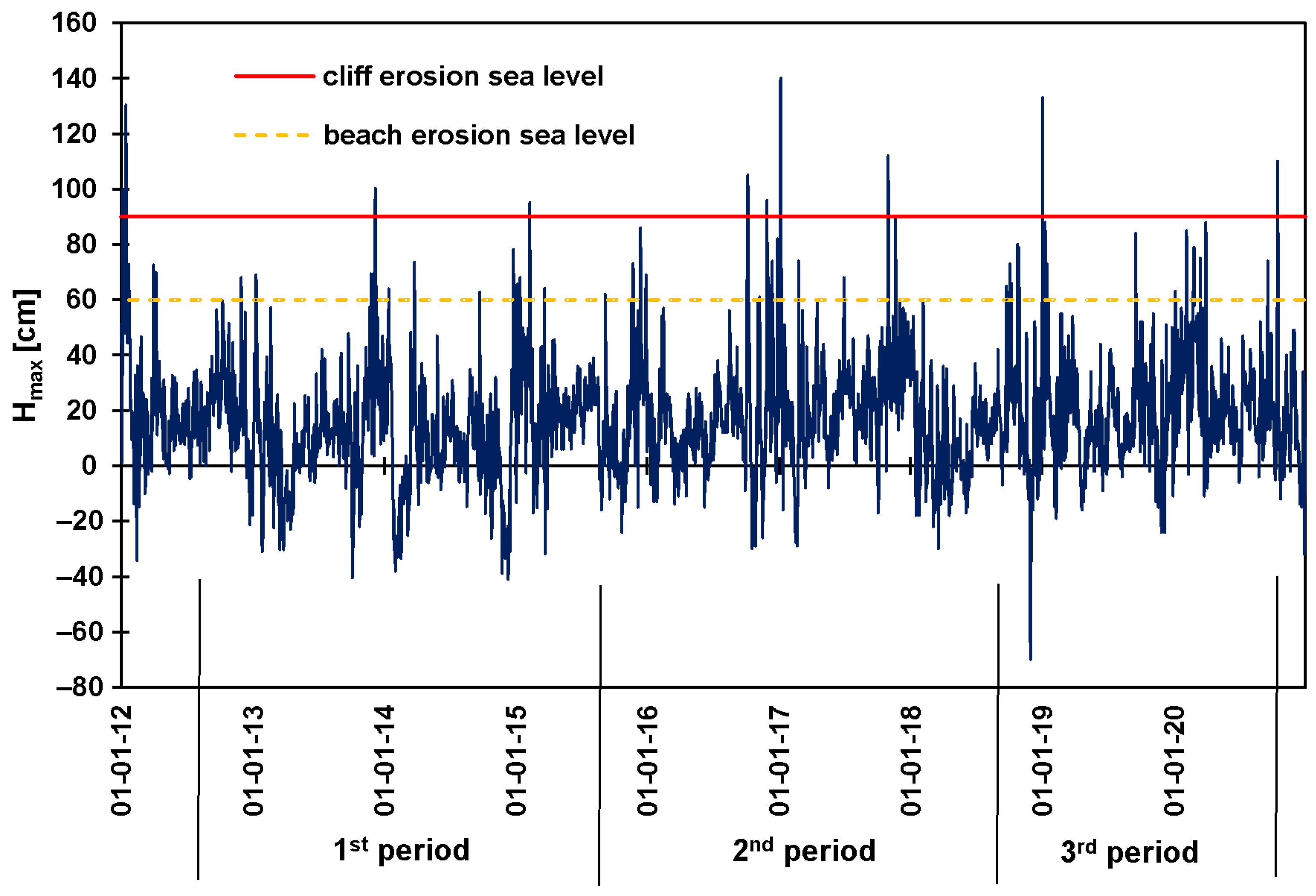
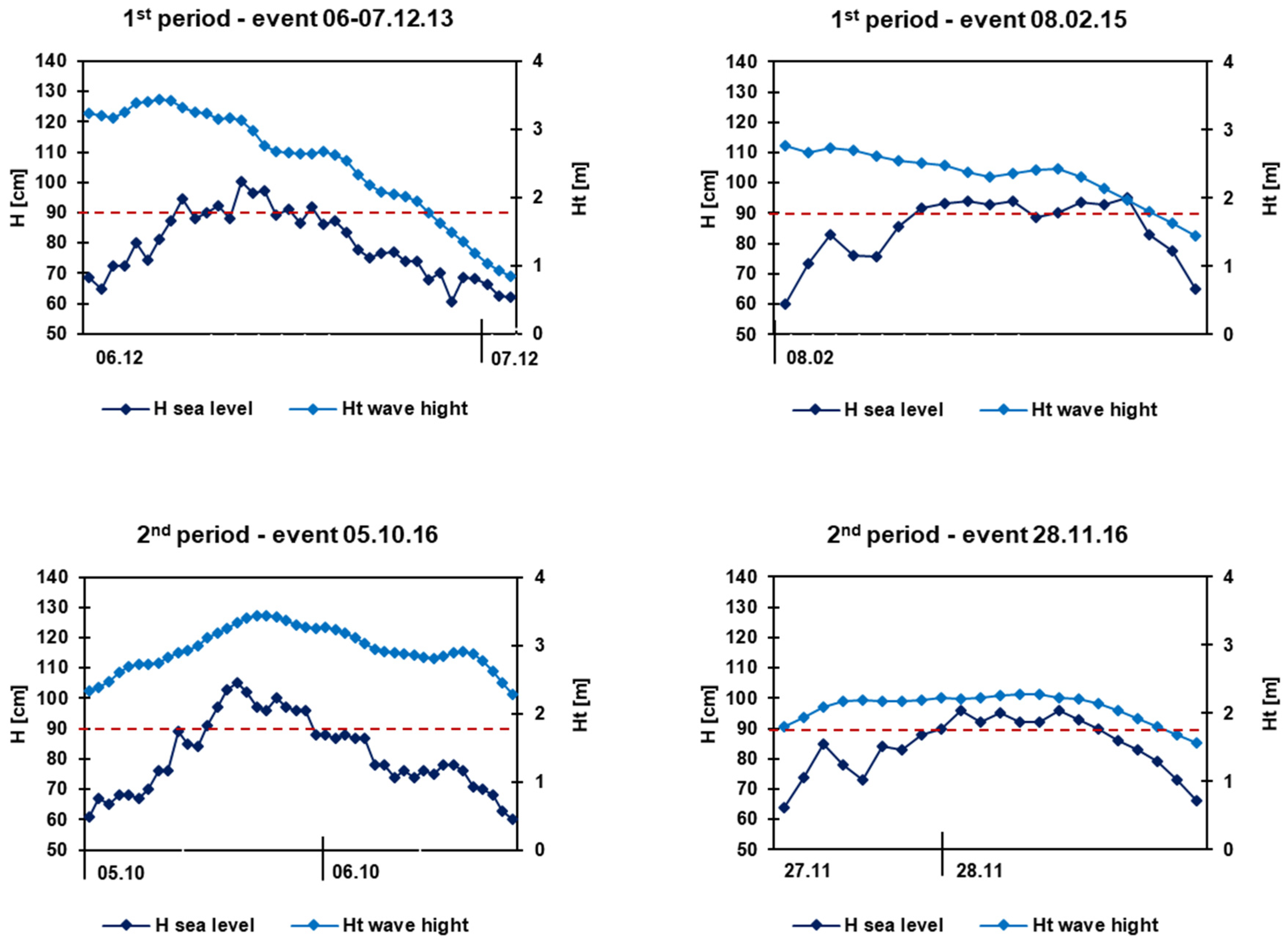
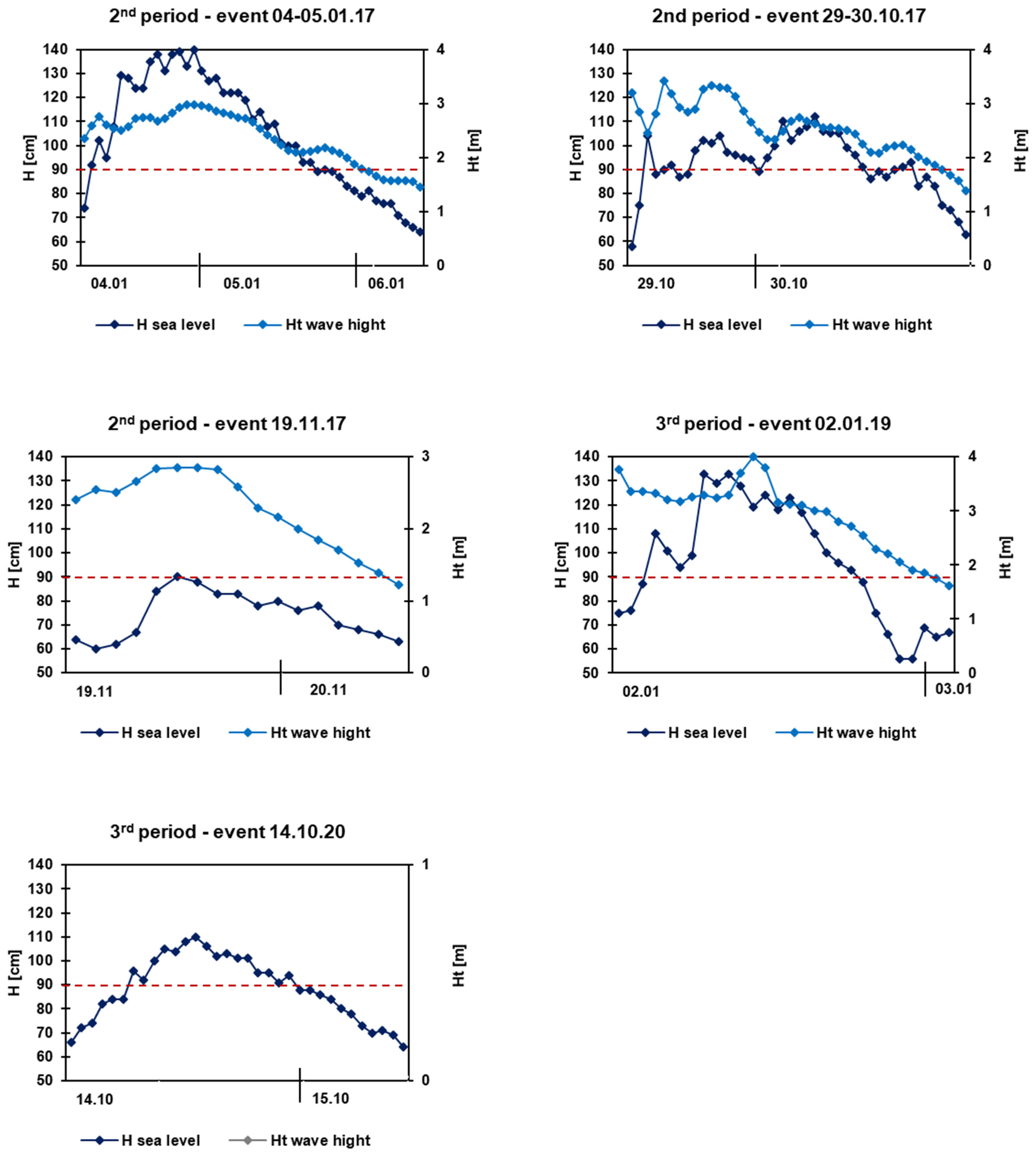
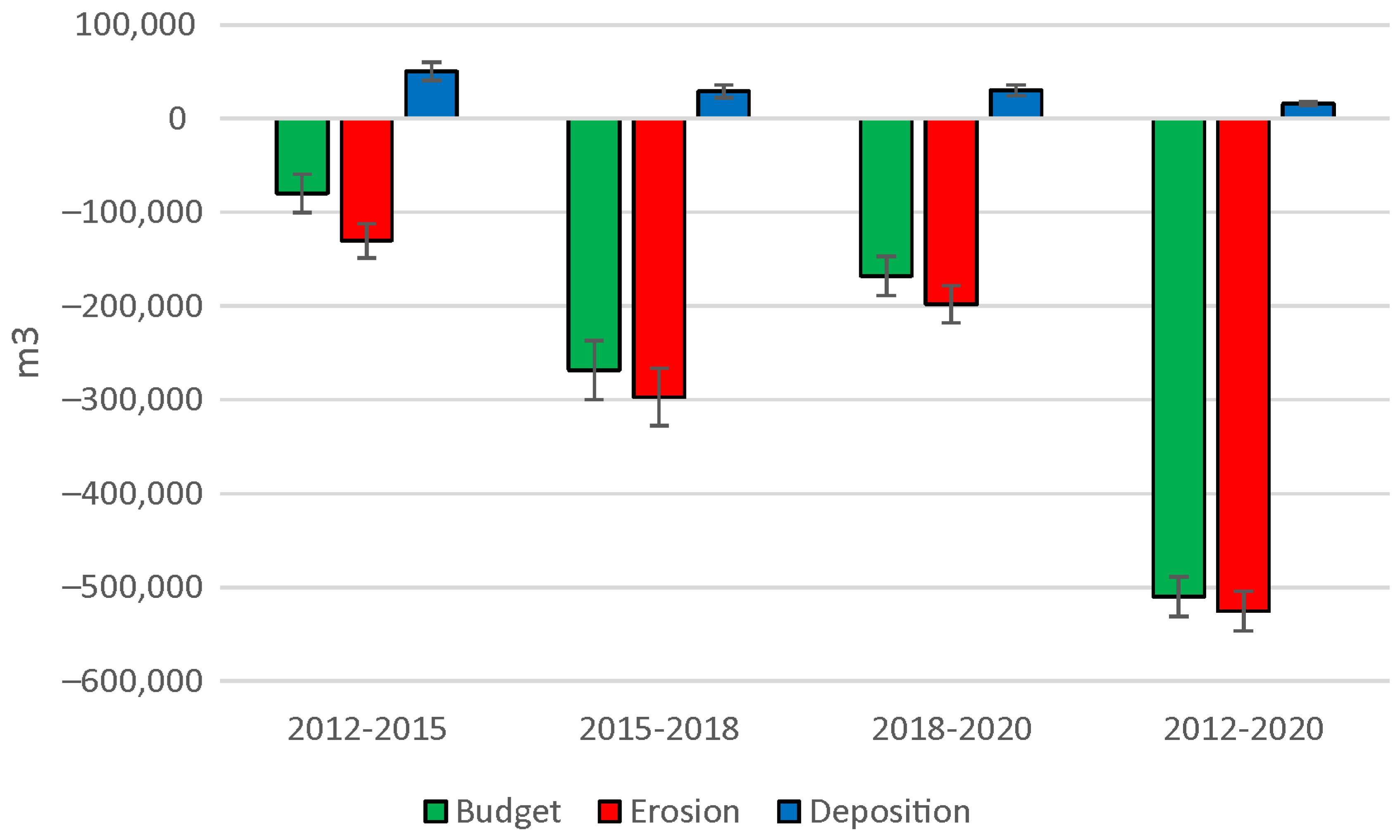
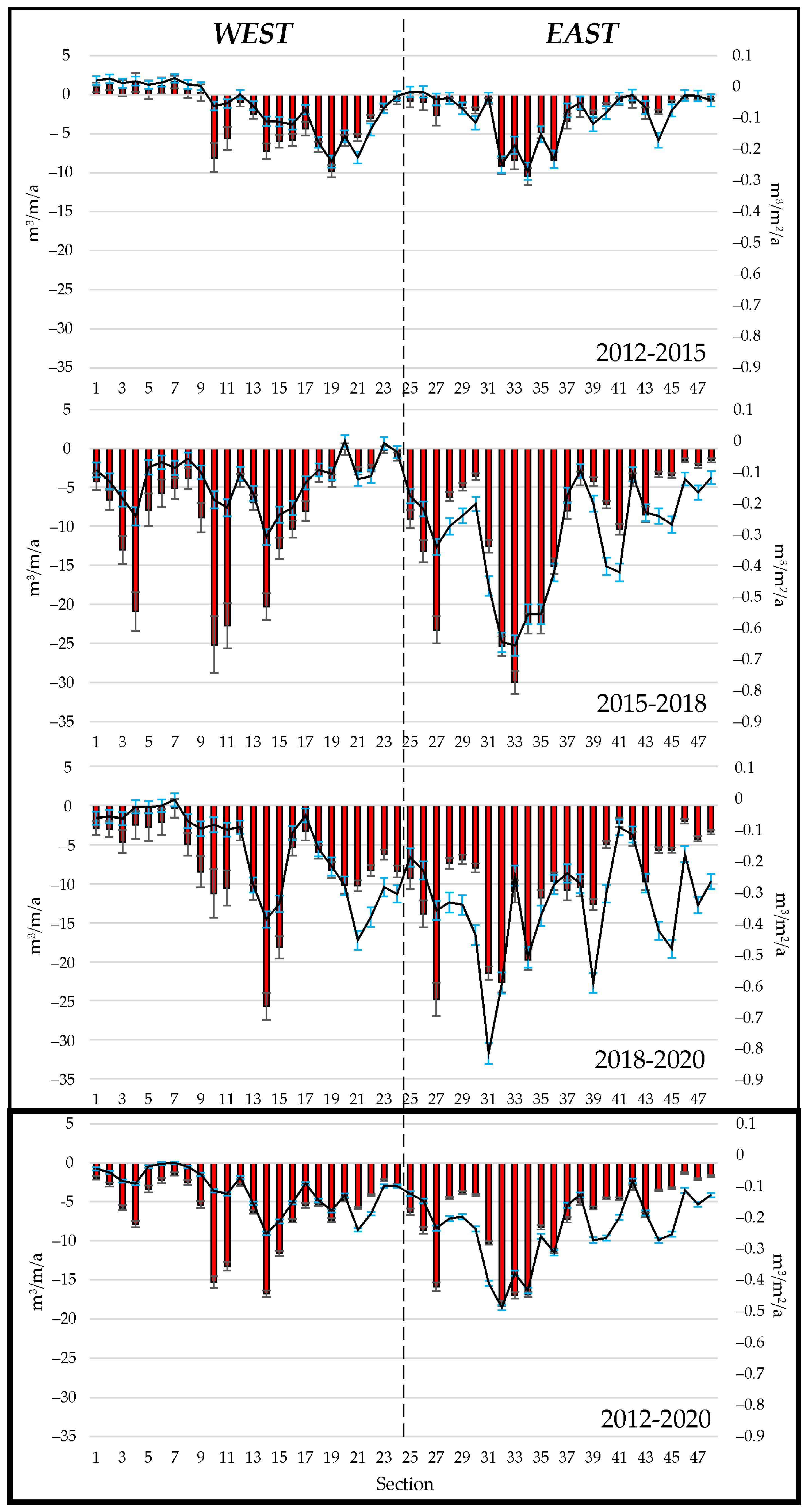
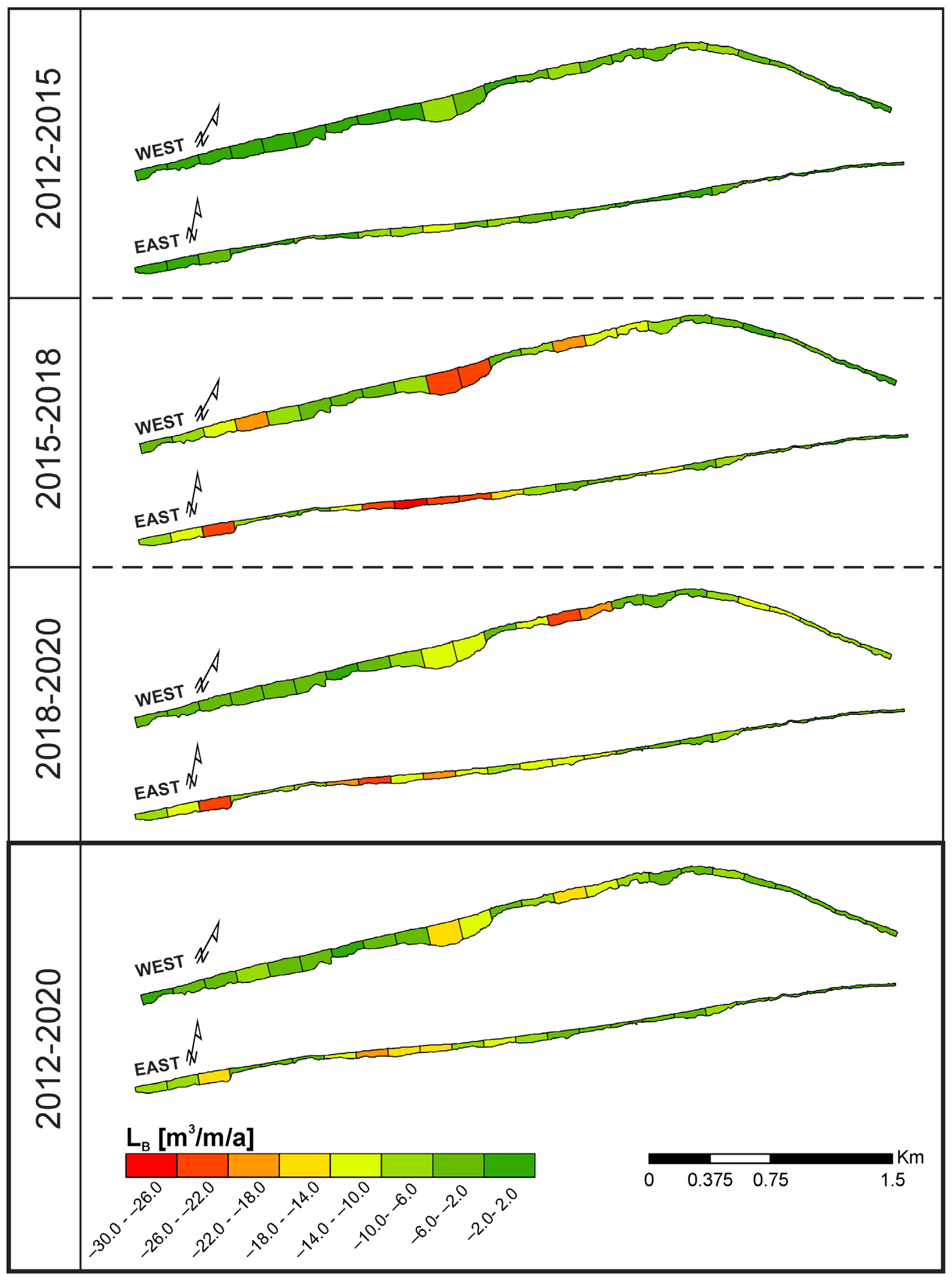
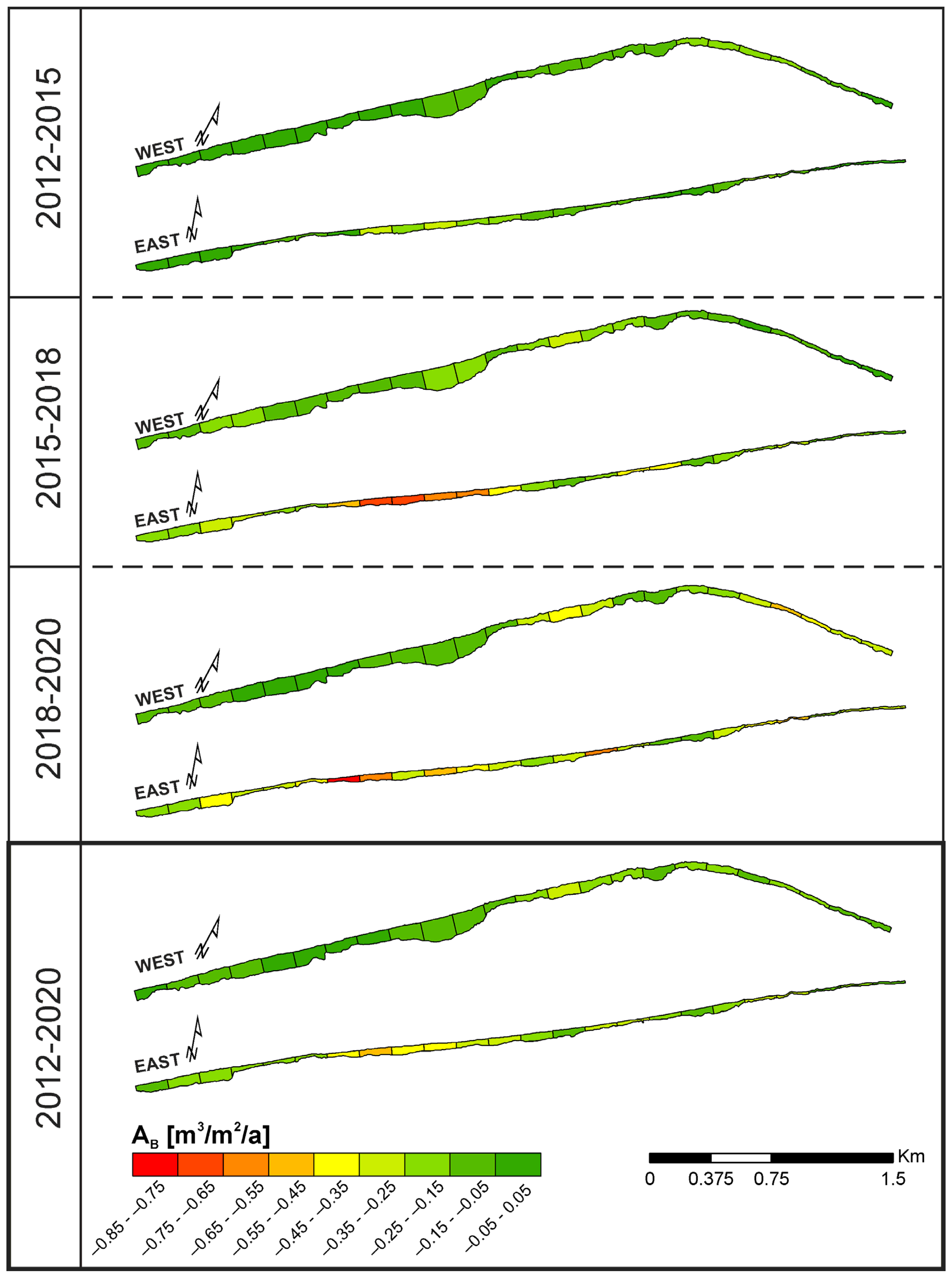
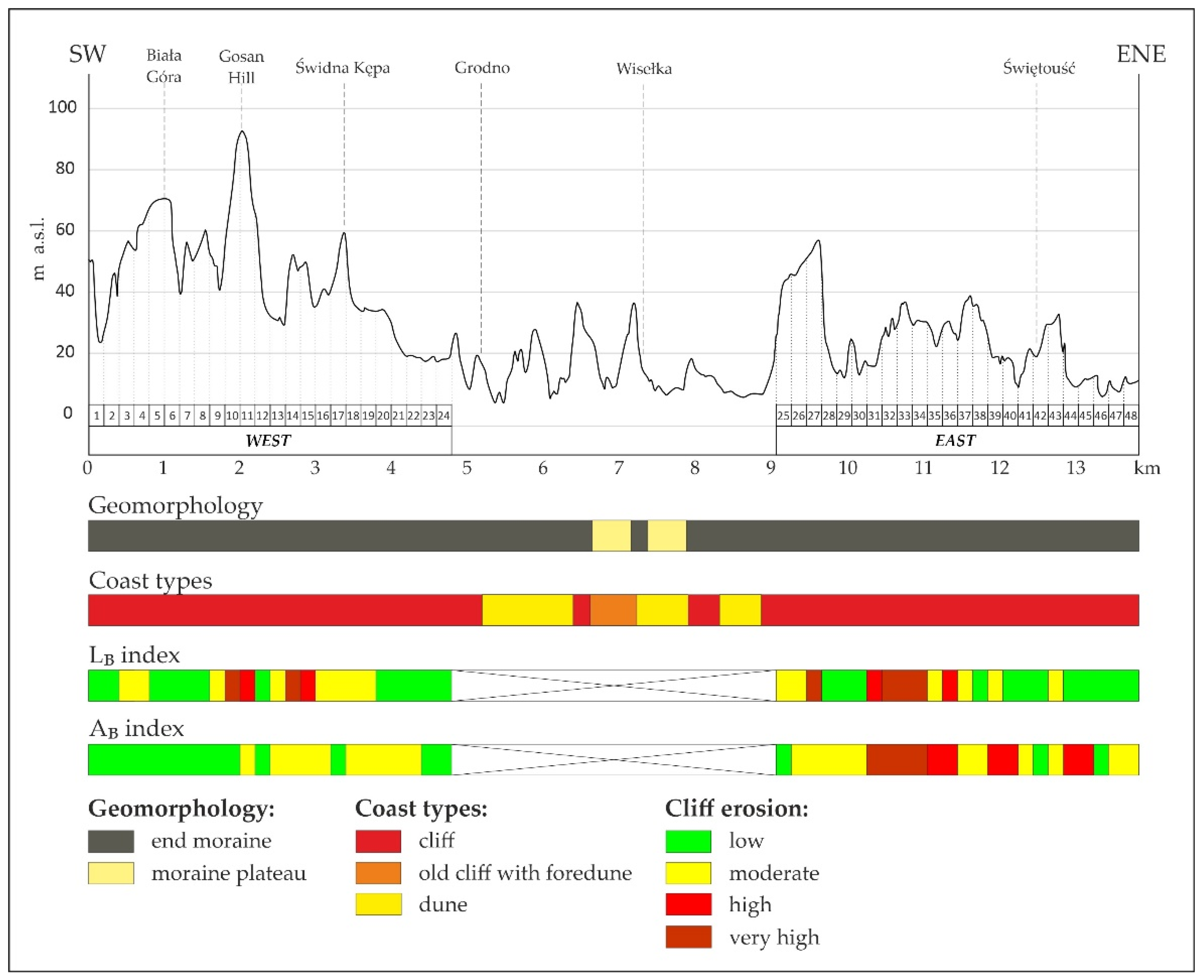
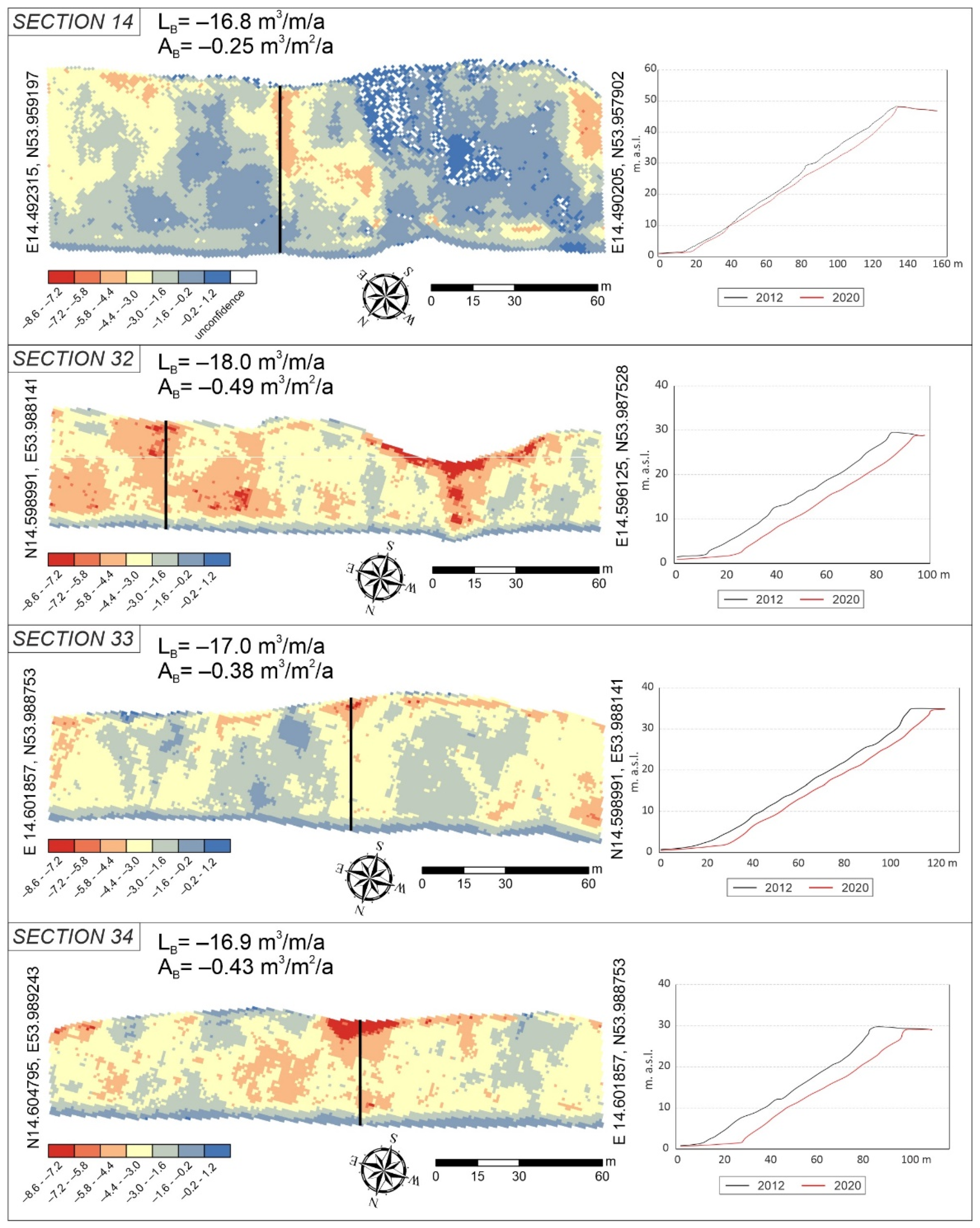
| Parameter | 2012 | 2015 | 2018 | 2020 |
|---|---|---|---|---|
| Number of points (all classes) | 216,253,380 | 437,275,340 | 431,853,371 | 492,283,200 |
| Number of points (class 2: ground) | 24,152,629 | 100,294,232 | 77,201,988 | 91,718,059 |
| Percent of ground points (%) | 11.17 | 22.94 | 17.88 | 16.63 |
| Point cloud density of ground points (pts/m2) | 3 | 7 | 6 | 8 |
| Survey date | 20 September 2012 | 26 September 2015 | 9 September 2018 | 20 October 2020 |
| DoD | West Section RMSE (m) | East Section RMSE (m) |
|---|---|---|
| 2012–2015 | 0.07 | 0.1 |
| 2015–2018 | 0.1 | 0.1 |
| 2018–2020 | 0.07 | 0.07 |
| 2012–2020 | 0.05 | 0.07 |
| The Intensity of Erosion | LB (m3/m/a) | AB (m3/m2/a) |
|---|---|---|
| Low | 1.00–5.25 | 0–0.125 |
| Average | 5.26–9.50 | 0.126–0.250 |
| High | 9.51–13.75 | 0.251–0.375 |
| Very high | 13.76–18.00 | 0.376–0.500 |
| Period | Date | Sea Level (cm) N.N. Reference Level | Number of Days | |||
|---|---|---|---|---|---|---|
| Haverage | Hmax | Hmin | Beach Erosion Sea Level Hmax ≥ 60 cm | Cliff Erosion Sea Level Hmax ≥ 90 cm | ||
| First | 28 September 2012–26 September 2015 | 3 | 100 | −106 | 21 | 3 |
| Second | 27 September 2015–9 September 2018 | 8 | 140 | −92 | 32 | 7 |
| Third | 10 September 2018–20 October 2020 | 9 | 133 | −126 | 30 | 2 |
| Total | 28 September 2012–20 October 2020 | 6 | 140 | −126 | 83 | 12 |
| Period | Number of Events | Time of Duration (h) | Data of Storm Surges | Hmax Sea Level Maximum (cm) | Have60 Sea Level Average by Hmax ≥ 90 cm (cm) | Have90 Sea Level Average by Hmax ≥60 cm (cm) | T90 Time of Duration by Hmax ≥90 cm (h) | T60 Time of Beach Erosion by Hmax ≥60 cm (h) | Hr90 Maximum Sea Level Rise by Hmax ≥90 cm (cm/h) | Hr60 Maximum Sea Level Rise by Hmax ≥60 cm (cm/h) | Ht90 Maximum/Considerable Wave Hight in Sea by Hmax ≥90 cm (m) (m) | Ht60 Maximum/Considerable Wave Hight in Sea by Hmax ≥60 cm (m) (m) | Wd Wave Direction/Shoreline Exposure (o) | Lb Storm Energy by Hmax ≥ 60 cm (Beach Erosion) | Lc Storm Energy by Hmax ≥ 90 cm (Cliff Erosion) |
|---|---|---|---|---|---|---|---|---|---|---|---|---|---|---|---|
| 28 September 2012–26 September 2015 | 2 | 17 | 6–7 December 2013 | 100 | 94 | 80 | 8 | 37 | 12 | 8 | 3.3/3.2 | 3.4/3.2 | 143/NW | 390 | 84 |
| 8 February 2015 | 95 | 93 | 85 | 9 | 19 | 6 | 14 | 2.5/2.4 | 2.8/2.6 | 169/N | 131 | 53 | |||
| 27 September 2015–9 September 2018 | 5 | 80 | 5 October 2016 | 105 | 98 | 81 | 11 | 44 | 7 | 13 | 3.4/3.4 | 3.4/3.3 | 214/NE | 481 | 128 |
| 28 November 2016 | 96 | 93 | 84 | 9 | 22 | 6 | 11 | 2.3/2.2 | 2.3/2.2 | 189/N | 108 | 45 | |||
| 4–5 January 2017 | 140 | 117 | 104 | 32 | 47 | 21 | 2 | 3.0/2.8 | 3.0/2.8 | 196/N | 370 | 252 | |||
| 29–30 October 2017 | 112 | 99 | 92 | 27 | 43 | 29 | 17 | 3.4/3.2 | 3.4/3.1 | 161/N | 408 | 274 | |||
| 19 November 2017 | 190 | 90 | 74 | 1 | 17 | 6 | 17 | 2.9/2.9 | 2.9/2.8 | 148/NW | 130 | 8 | |||
| 10 September 2018–20 October 2020 | 2 | 33 | 2 January 2019 | 133 | 113 | 97 | 17 | 28 | 34 | 13 | 4.0/3.5 | 4.0/3.5 | 195/N | 342 | 207 |
| 14 October 2020 | 110 | 100 | 88 | 16 | 33 | 12 | 8 | - | - | - | - | - | |||
| 28 September 2012–20 October 2020 | Total | Maximum | |||||||||||||
| 9 | 130 | 140 | 100 | 87 | 32 | 47 | 29 | 17 | 4.0/3.5 | 4.0/3.5 | 481 | 274 | |||
| Period | TB [m3] | LB (m3/m/a) | AB (m3/m2/a) | ||||
|---|---|---|---|---|---|---|---|
| Mean | Min | Max | Mean | Min | Max | ||
| 2012–2015 | −79,904 | −2.8 | 1.6 | −10.5 | −0.06 | 0.03 | −0.27 |
| 2015–2018 | −268,346 | −9.3 | −0.06 | −30 | −0.22 | 0.00 | −0.66 |
| 2018–2020 | −168,090 | −8.9 | −0.35 | −25.7 | −0.26 | −0.01 | −0.82 |
| 2012–2020 | −509,909 | −6.6 | −1.3 | −18 | −0.17 | −0.03 | −0.49 |
Publisher’s Note: MDPI stays neutral with regard to jurisdictional claims in published maps and institutional affiliations. |
© 2022 by the authors. Licensee MDPI, Basel, Switzerland. This article is an open access article distributed under the terms and conditions of the Creative Commons Attribution (CC BY) license (https://creativecommons.org/licenses/by/4.0/).
Share and Cite
Winowski, M.; Tylkowski, J.; Hojan, M. Assessment of Moraine Cliff Spatio-Temporal Erosion on Wolin Island Using ALS Data Analysis. Remote Sens. 2022, 14, 3115. https://doi.org/10.3390/rs14133115
Winowski M, Tylkowski J, Hojan M. Assessment of Moraine Cliff Spatio-Temporal Erosion on Wolin Island Using ALS Data Analysis. Remote Sensing. 2022; 14(13):3115. https://doi.org/10.3390/rs14133115
Chicago/Turabian StyleWinowski, Marcin, Jacek Tylkowski, and Marcin Hojan. 2022. "Assessment of Moraine Cliff Spatio-Temporal Erosion on Wolin Island Using ALS Data Analysis" Remote Sensing 14, no. 13: 3115. https://doi.org/10.3390/rs14133115
APA StyleWinowski, M., Tylkowski, J., & Hojan, M. (2022). Assessment of Moraine Cliff Spatio-Temporal Erosion on Wolin Island Using ALS Data Analysis. Remote Sensing, 14(13), 3115. https://doi.org/10.3390/rs14133115





